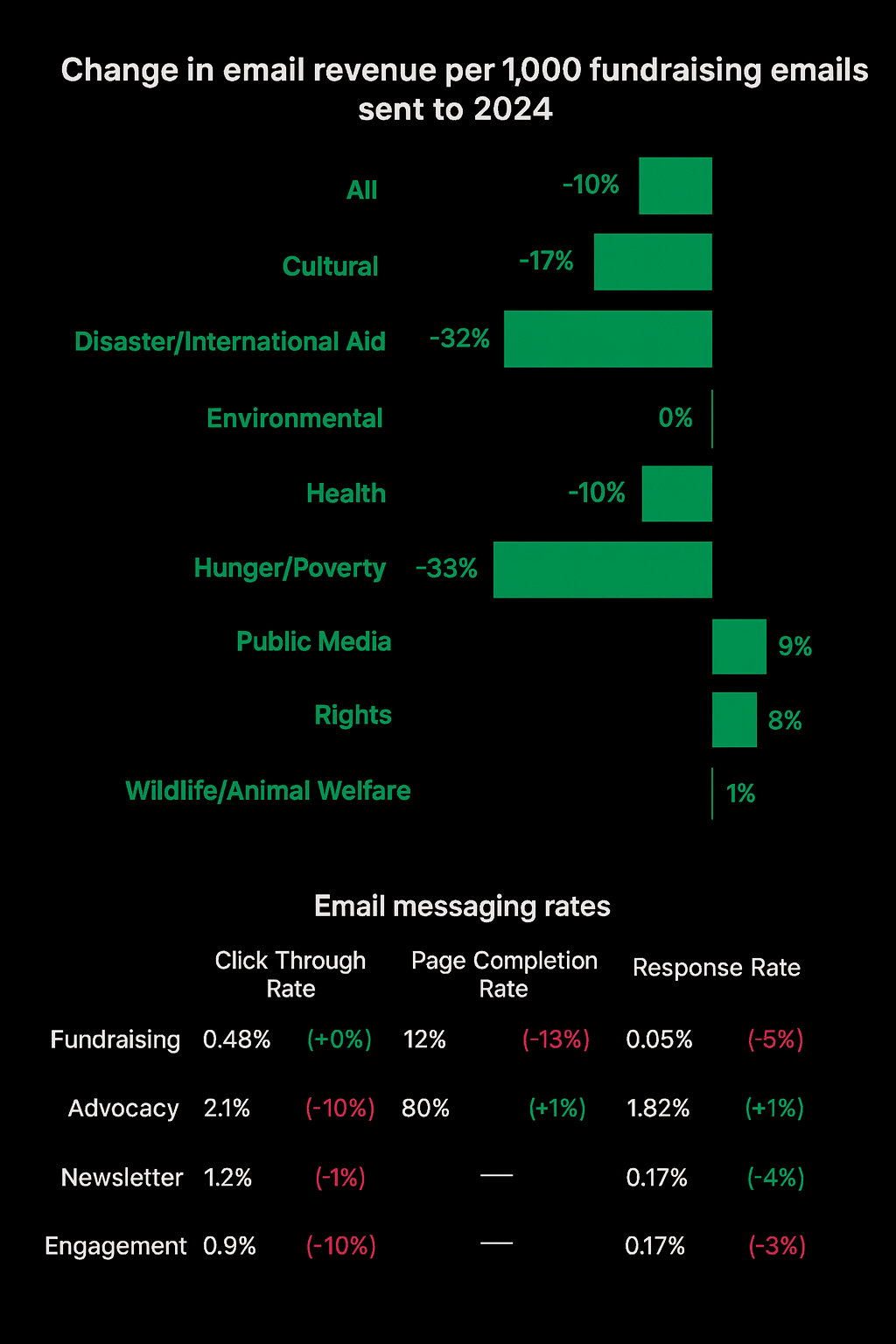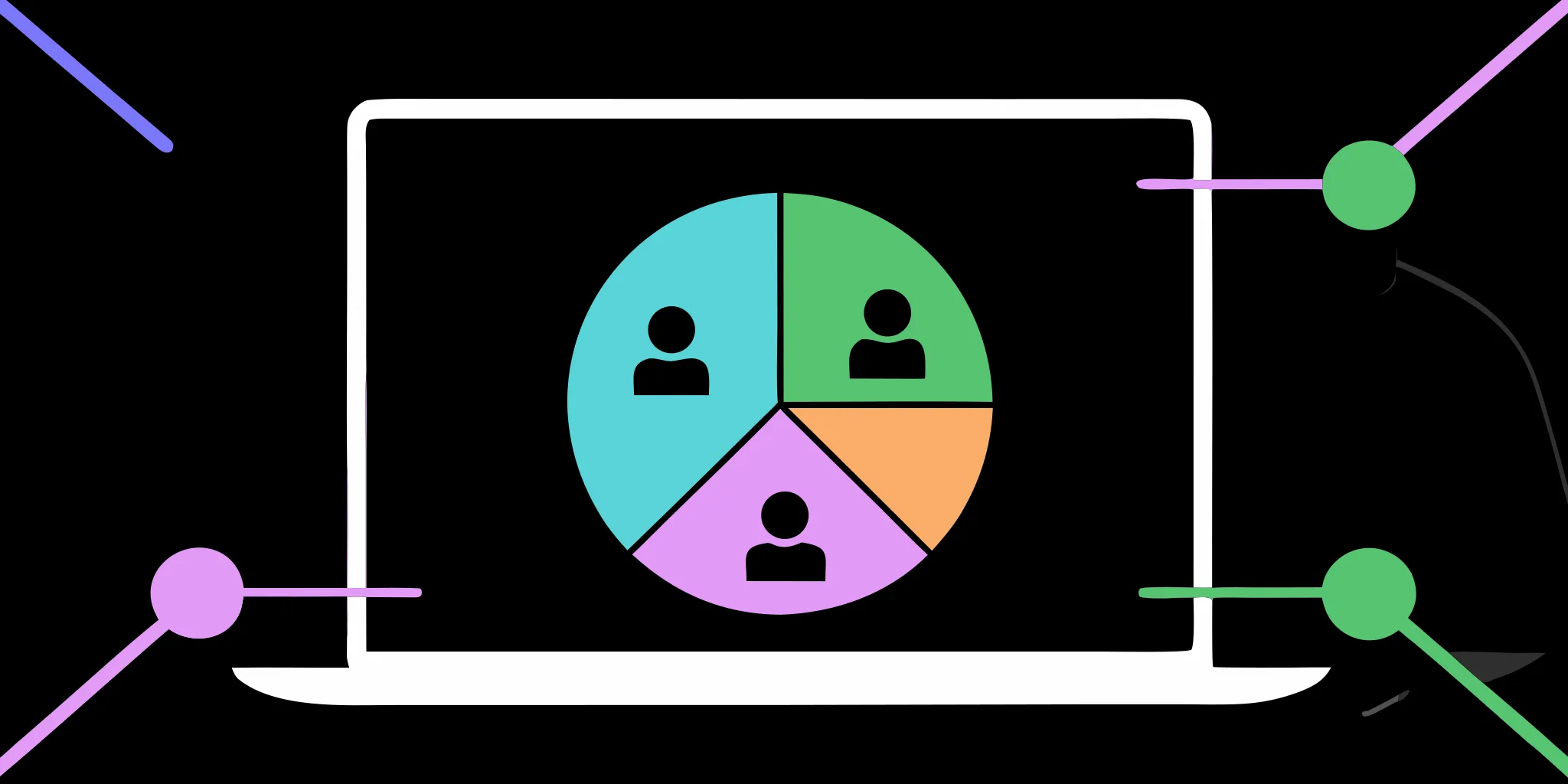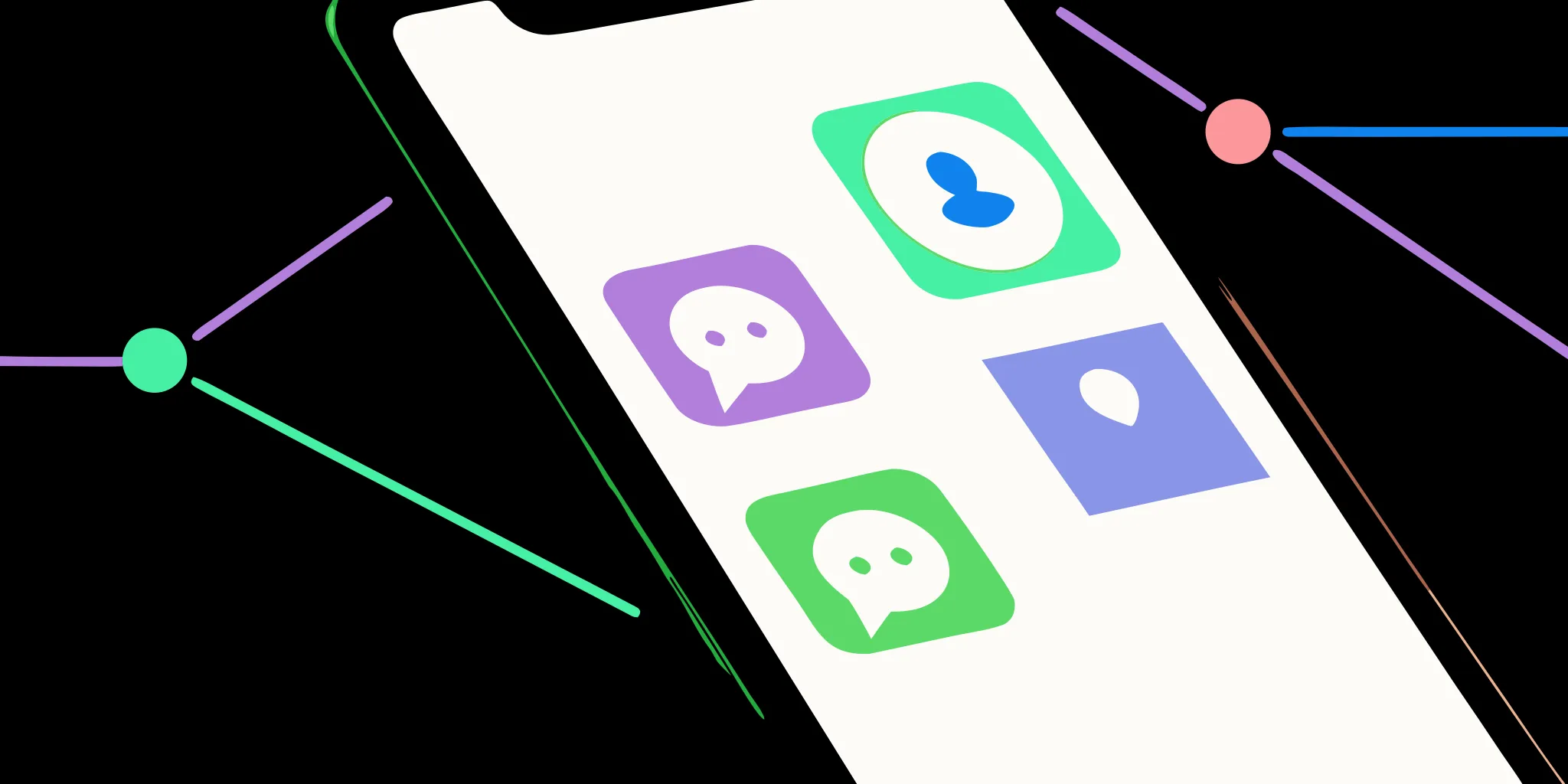
Donor Decline → Supporter Migration → Social DM Fix
Addressing the Nonprofit Donor Crisis with Data-Driven Strategy
Donor Base Decline: The New Reality
Nonprofits face an alarming donor shrinkage. Even as total giving dollars rose modestly, donor counts have dropped for multiple years, signaling an unsustainable trend. Fewer individuals are giving, placing greater reliance on a shrinking core of major donors. This contraction in grassroots support is a red flag for long-term fundraising health and mission impact. It underscores an urgent need to rejuvenate broad-based donor engagement before revenues erode.
- Donors down 4.5% – The number of donors fell 4.5% in 2024 (vs. 2023) despite a bump in dollars raised. This was the 4th consecutive annual decline in donor participation.
- Retention slipping – Donor retention rates dropped ~2.6% in 2024, meaning nonprofits are struggling more than ever to renew supporters. Many first-time donors aren’t coming back.
- Acquisition challenges – New donor counts fell ~7% year-over-year. Even fewer new supporters are entering the pipeline, exacerbating the decline. First-year retention is also dismal (newly retained donors fell 8%), indicating that the few new people who do give often don’t stick around.
Traditional Channels, Diminishing Returns
Traditwional fundraising channels are losing steam. Nonprofits are working harder through email and similar outreach, but returns are stagnating. In 2024 many organizations increased their email volume, appeals, and marketing pushes – yet overall response and revenue declined. The conventional tactics that fueled past growth are no longer keeping up, pointing to a need for new strategies.
- More emails, less revenue: Nonprofits sent 9% more emails in 2024, but email-sourced revenue dropped 11% on average. Email contributed only ~11% of online giving, down from 14% the year prior – a shrinking slice of the fundraising pie.
- Diminishing email returns: For every 1,000 fundraising emails sent, nonprofits raised just $58 in 2024, a 10% decrease vs. 2023 The audience is tuning out despite higher send volume.
- Low engagement rates: Nonprofit marketing emails average only about a 25–30% open rate – meaning roughly 3 out of 4 supporters never even see the message. By contrast, newer channels like social direct messages see 80%+ open rates, highlighting the engagement gap.
Supporter Migration to Social Platforms
If donors aren’t responding through traditional channels, where have they gone? The answer: online social platforms. Supporters today spend their time on Facebook, Instagram, and other social media – engaging with causes there, but not necessarily through old channels. Nonprofit leaders acknowledge their donor base is aging and limited, and that they need to reach younger supporters on social to reinvigorate growth. The challenge is converting this vast social media engagement into giving.
- Untapped social audiences: Many organizations have amassed large followings on social media yet see “very little” fundraising return or donor data from those followers. Current Facebook efforts often yield minimal revenue and almost no information about who these supporters are. This indicates a huge untapped pool of potential donors interacting with nonprofit content but not entering the donor database.
- New donors are on social: The few nonprofits who are converting social media engagement into giving report that over 90% of people acquired via social direct messaging are completely new to the house file. In other words, the vast majority of supporters reached through social messaging are net new donors, not cannibalizing your existing list. This is a pivotal insight: your next generation of donors is out there on social platforms, ready to be engaged.
Social DM: A New Critical Channel
Social Direct Messaging (DM) has emerged as the strategic, data-backed answer to donor decline. It represents the “next critical channel” in fundraising – one that meets supporters where they already are (on social) and engages them in a personalized way. Through platforms like Facebook Messenger (and others), nonprofits can start one-on-one conversations at scale, drastically improving reach and response. This isn’t a speculative idea; it’s already proving to be a game-changer for those embracing it. Social DM offers an immediate line of communication that cuts through the noise: messages arrive in supporters’ social inboxes where open rates of 80–90% are common. Executives concerned about declining email efficacy should see social DM as a way to dramatically increase the percentage of supporters who actually read and interact with your outreach.
- Exceptional engagement: Direct messages on social media boast 80–90% open rates, far eclipsing email’s ~25%. Supporters are 3x more likely to open a Facebook or Instagram message from your organization than an email. This means your campaigns and stories get in front of nearly everyone you contact, not just a sliver of your list. High open rates translate to more opportunities to inspire and convert supporters.
- Personal connection at scale: Social DM enables two-way, personal storytelling with supporters. People aren’t just passive recipients – they reply and share their own stories and motivations via Messenger, creating an emotional dialogue. This “listening at scale” approach builds genuine relationships, making supporters feel heard and valued. It aligns perfectly with nonprofits’ relationship-centric values and fosters deeper loyalty than one-way email blasts.
- From engagement to action: Because it feels personal, direct messaging is highly effective at nurturing supporters from interested to invested. Organizations have found that conversational messaging can convert one-time Facebook fundraisers into repeat donors, boost recurring giving enrollments, and improve overall retention. In short, social DM doesn’t just acquire new donors—it helps keep them by building a continuous, tailored communication stream that encourages ongoing support.
Driving Engagement and Retention via Conversation
Social DM isn’t just about quick wins – it’s fundamentally about sustainable supporter relationships. Through automated-yet-humanized messaging flows, nonprofits can send tailored updates, thank-yous, impact stories, and campaign invites in a conversational tone. Each supporter receives content that feels one-on-one, increasing their connection to the cause. This translates into stronger long-term metrics: higher second-gift rates, better retention, and more advocates for the mission.
In practice, this looks like sending a Facebook Messenger follow-up to someone who just participated in a fundraising challenge – asking why they care about the cause, listening to their story, and then inviting them to stay involved. Supporters respond with heartfelt messages, photos, even personal testimonies. That data not only enriches your CRM, it enables you to segment and personalize future asks in a way email cannot. By treating each supporter as a partner in dialogue, social DM helps migrate casual followers into loyal donors, addressing the retention crisis head-on. It’s a modern form of donor stewardship: high-tech, but with a human touch at scale.
(The power of this approach is evident: nonprofits consistently report “wow” moments when seeing supporters share emotional stories via DM, something unheard of in mass email. This depth of engagement creates the kind of loyalty and passion that drives lifetime value.)
Turnkey Implementation, Zero Bandwidth Strain
A key concern for any new initiative is bandwidth. Most nonprofit teams are stretched thin – many have “very small marketing/fundraising teams” or vacant roles limiting capacity. The good news: implementing a Social DM program is turnkey and executive-friendly. GoodUnited (the leader in social DM for nonprofits) provides a done-for-you solution, handling everything “soup to nuts” with minimal effort required from nonprofits. This means your team does not need to hire new staff or become social media experts to launch this channel.
- Minimal lift required: GoodUnited’s service is essentially plug-and-play. Their team sets up the messaging campaigns, conversation flows, and targeting, then manages the day-to-day interactions with supporters. For your nonprofit, the workload impact is negligible – often just initial alignment on goals/voice and periodic check-ins. It’s designed to be **“immediately net positive” in value while being low labor for you, addressing both budget and staff capacity concerns upfront.
- Bandwith relief: By outsourcing the heavy lifting, your small team can achieve big results without adding tasks to their plates. This alleviates the common “we don’t have time or people” roadblock. In fact, organizations often describe the experience as “music to the ears” of their lean teams. You get a sophisticated new fundraising channel essentially out-of-the-box, allowing staff to stay focused on other priorities while the social DM program runs in the background (generating new donors and donations).
Proven Results and ROI
You might ask: does Social DM really deliver? The track record speaks for itself. Data from the past five years shows remarkable results, proving that this isn’t just a novel idea but a repeatable success model. Organizations leveraging social direct messaging with GoodUnited have seen significant revenue boosts and donor growth that would be hard to achieve otherwise.
- Significant new revenue: More than $151 million has been raised through social DM campaigns over five years, generating 8.8 million engaged supporter leads for nonprofits in the process. These are substantial dollars that came largely from individuals who would not have given through traditional channels. Each of those millions of touchpoints represents a potential long-term supporter brought into the fold.
- High ROI: Social DM initiatives are yielding an impressive 270% return on ad spend (ROAS) on average. For every $1 invested in social messaging ads to recruit participants, nonprofits are seeing about $2.70 in return. This 2.7x ROI is a strong testament to the channel’s efficiency. It outperforms many traditional fundraising investments, meaning that budget put toward social DM multiplies in value. Executives can feel confident that this strategy not only pays for itself but drives net new revenue.
- Scalable success: Importantly, these outcomes aren’t from one lucky campaign – they’ve been replicated across numerous organizations and campaigns, from peer-to-peer challenges to year-end giving drives. The consistency of results (when the model is applied correctly) shows that social DM’s impact is sustainable and scalable, not a one-time fluke. It provides a dependable growth lever in an era when reliability is hard to come by.
Addressing Executive Concerns
It’s natural for CEOs and senior executives to have questions or hesitations about a new approach. The common objections we’ve heard include budget limitations, fear of donor overlap (cannibalization), and general skepticism of unproven tactics. We take these concerns seriously – and the data and experiences to date offer reassuring answers:
- Budget: “We didn’t budget for this.” Upfront cost is a real concern, but there are ways to make it workable. Some nonprofits have tapped third-party funding or grants to offset the costs of launching social DM. More importantly, the strong ROI means the program quickly pays for itself – with a 270% ROAS, the revenue return far exceeds the spend. Rather than an expense, consider it an investment with demonstrated positive returns. We can also scale the program to your budget size, starting with a pilot if needed.
- Cannibalization: “Will this pull donors or dollars away from our existing campaigns?” We purposefully design social DM campaigns to complement, not compete with, your current efforts. In fact, GoodUnited’s strategy is to target new audiences not already in your database, and to exclude your active donors from social recruitment ads. This ensures we are reaching net new supporters (as the 90% new donor stat showed) rather than diverting your current donor base. The result is additive growth – bringing in incremental donors and revenue that likely wouldn’t have been captured otherwise. Your traditional channels continue as is, and social DM becomes a new growth stream.
- Results Skepticism: “We’ve tried things on Facebook before and didn’t see much. How do we know this will work?” It’s true many organizations have Facebook followings that haven’t translated into fundraising success – which is exactly why a direct, conversational approach is different. Early adopters of social DM have proven it can unlock the potential where generic social posts or fundraisers alone failed. The data (millions raised, new donors acquired) is our evidence. One nonprofit executive candidly noted, “It’s hard for me to determine how this would be successful other than trying it”. We agree – the best way to evaluate it is to see it in action. That’s why we often start with a modest pilot campaign. Once leaders witness supporters enthusiastically engaging through Messenger – and the donations coming in – the skepticism gives way to excitement. In sum, the model has been de-risked by others in the sector; you won’t be the first – and we will transparently share performance data every step of the way.
(Other concerns like internal approval and brand control are also manageable – we work within your organization’s review processes and ensure messaging aligns with your voice and standards. You maintain oversight; we handle the heavy lifting.)
Future-Proofing Your Fundraising
The market is shifting, and nonprofits that adapt will thrive. Embracing social direct messaging is not just a short-term tactic, but a strategic move to future-proof your fundraising. Donor preferences are evolving in real-time – they expect personalization, dialogue, and digital convenience. Social DM delivers on these expectations, positioning your organization at the cutting edge of engagement. Forward-thinking nonprofits are already onboarding to this channel, driven by a fear of “falling behind” if they don’t act.
This is a pivotal moment: by acting now, you capture the first-mover advantage in your space, galvanize a new generation of supporters, and reverse the donor decline trajectory. It’s rare to find a solution that so directly addresses a core problem with such clear upside. Social DM is that solution – a data-backed, emotionally resonant, and operationally feasible fix to the donor crisis. It aligns with your mission (building community and support), it’s proven in its impact, and it’s turnkey to implement. The time is now to pivot from worrying about donor losses to confidently investing in an approach that grows and sustains your supporter base. In doing so, you’ll not only hit immediate fundraising goals but also set your organization up for long-term success in the new era of social, conversational philanthropy.
Let’s future-proof your mission by meeting supporters where they are and giving them a reason to stay. The donors are out there – let’s invite them in.
Sources:
mrbenchmarks.commrbenchmarks.com


















